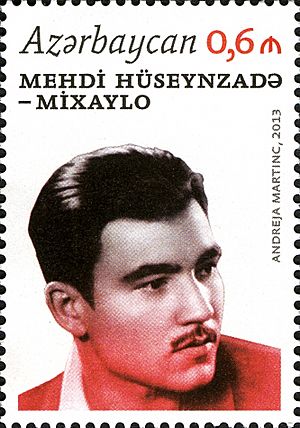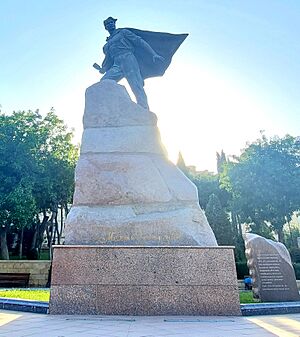Mehdi Huseynzade facts for kids
Quick facts for kids
Mehdi Huseynzade
Mehdi Hənifə oğlu Hüseynzadə |
|
|---|---|
 |
|
| Nickname(s) | Михайло (Mikhailo) |
| Born | 22 December 1918 Novxanı, Baku Governorate, Azerbaijan Democratic Republic |
| Died | 16 November 1944 (aged 25) Vitovlje, Kingdom of Italy (now Slovenia) |
| Buried |
Čepovan, Nova Gorica, Slovenia
|
| Allegiance | |
| Service/ |
Partisans |
| Years of service | 1941–1944 |
| Rank | Lieutenant |
| Unit | 9th Corps of Yugoslav Partisans |
| Commands held | Reconnaissance and sabotage group |
| Battles/wars | Battle of Stalingrad World War II in Yugoslavia |
| Awards | Hero of the Soviet Union |
Lieutenant Mehdi Huseynzade (born December 22, 1918, in Novxanı, Azerbaijan; died November 2, 1944, in Vitovlje, Slovenia) was a brave Azerbaijani guerrilla fighter and scout during World War II. He was given the special title of Hero of the Soviet Union after his death on April 11, 1957, for his amazing courage.
Contents
Biography
Early Life
Mehdi Huseynzade was born on December 22, 1918. His hometown was Novxanı in the Baku province of the Azerbaijan Democratic Republic. After finishing the Baku Art School, Mehdi went on to study at the Leningrad Institute of Foreign Languages. In 1940, he returned to Baku. There, he continued his education at the Azerbaijan State Pedagogical University.
World War II Begins
In August 1941, Germany invaded the Soviet Union. This started a big part of World War II called the Eastern Front. Mehdi Huseynzade joined the Red Army at this time. In 1942, he finished military school in Tbilisi. He was then sent to the front lines. There, he led a group using mortars during the famous Battle of Stalingrad.

In August 1942, near the town of Kalach-na-Donu, Mehdi was badly hurt. He was then taken as a prisoner of war by the Germans. He spent about a year and a half in German prison camps. These camps were located in Northern Italy and Yugoslavia. In early 1944, Mehdi and two other Azerbaijani prisoners, Javad Hakimli and Asad Gurbanov, managed to escape. They joined the Yugoslav Partisans, who were brave fighters against the Germans. Later that year, Mehdi became a leader of a special scouting and sabotage team. This team was part of the 9th Corps of the People's Liberation Army of Yugoslavia. It was here that he earned his special nickname, Mikhailo.
A Brave Partisan
In January 1944, Mikhailo and his team bravely captured important maps from the enemy. The next month, Mehdi dressed up as a German officer. He snuck into German barracks and placed a bomb inside a fire extinguisher. This bomb then blew up the main room.
On April 2, 1944, Huseynzade and another Azerbaijani partisan, Mirdamat Seidov, set a hidden mine. They placed it in the Villa Opicina cinema near Trieste. The explosion caused many casualties among German soldiers. In late April 1944, Huseynzade, Hans Fritz, and Ali Tagiyev blew up a bridge. This was near the Postojna railway station. This caused a train with 24 cars to crash. In May, Huseynzade and Seidov blew up a casino in Trieste. This also caused many casualties among German officers. The Germans became very worried about these attacks. They offered a large reward of 400,000 Italian liras to anyone who could kill Huseynzade.
His Final Mission
On November 2, 1944, Mikhailo was returning from a successful mission. He had just destroyed a German ammunition storage area. Near the town of Vitovlje in Slovenia, he walked into a German ambush.
Awards and Honors
Mehdi Huseynzade's life and bravery during World War II are remembered in many ways. His story was told in a book called On Distant Shores by Imran Gasimov. A movie with the same name was also made by the Azerbaijanfilm studio. A football stadium in Sumgayit is named after him. There are also monuments built in his honor. You can find these monuments in Baku, his hometown of Novkhany, Azerbaijan, and near Nova Gorica, Slovenia.
Family
Mehdi Huseynzade had two sisters named Bikya Khanum and Huriet. His nephew, Agshin Alizadeh, became a famous composer in the Soviet Union and Azerbaijan.



